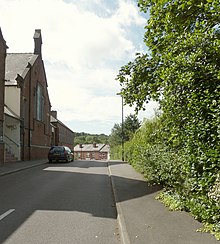Kate Dover
Felicia Dorothea Kate Dover (1855 – 26 March 1925) was an English woman who was tried for murder and convicted of manslaughter in 1882 following the death of Thomas Skinner from arsenic poisoning.
[3] Her trial was a major event at the criminal court in Leeds Town Hall; it was attended by many people and attracted significant newspaper coverage.
[nb 1][8][9][10][11] He was possibly associated with the wood carver, and bread and butter platter maker, Frederick William Dover (St Paul's, Norwich, ca.
[12][13][14][15] The making of carved sycamore bread and butter platters and wooden knives had been introduced to Sheffield around 1851 by Prince Albert.
[41] "The keynote to her character [was] extreme excitability ..." Before her appointment with Skinner, "she was accustomed to dress well, and sometimes with a good deal of taste; and she came to be popularly known as the Heeley Queen," but by the end of their acquaintance her clothes had "become very shabby".
[2] In autumn 1880, she became housekeeper to widower Thomas Skinner (1819–1881) of Sheffield, who was a well-to-do inventor, etcher, and painter.
[43][44] On 6 December 1881, Dover killed her employer and "sweetheart",[39] Skinner, by cooking him a roast dinner with arsenic in the stuffing.
[7] He suggested that Dover's motive for the poisoning might not have been to kill, but to make Skinner ill and blame Jones for it, thereby undoing the influence of the objector to the marriage.
[6][7] She was a working-class but well-educated artist in an industrial town, with the virtues of regular employment, temperance and an attractive and fashionable appearance.
[37] Yet she was apparently content to obey her employer's instructions to supply his daily requirement of ale,[11] and to meet him willingly in a public house,[39] a type of place which respectable women did not enter alone at that time.
[48] She went home from the house of her "old sweetheart",[39] Skinner, to her parents every night, apparently leading a socially respectable life.
It was stated that Kate Dover "was goodlooking and young, and the jury, taking a merciful view of a very strong case of poisoning, found her guilty of manslaughter only.
It was stated in the British Medical Journal that "Coupling the sentence with the verdict, the conclusion is irresistible, that the judge thought the jury had taken a very lenient view of the matter.
After leaving prison, or at least by 1901,[52] Kate lived with her sister Mary and her brother-in-law Edwin Sissons, a baker-confectioner, at 19 Carlton Avenue, Rotherham.
[52] By 1911, Kate had moved and was living at 423 Bardsley Moor Lane, Rotherham, with her widowed sister Amelia H.C.
She died aged 69 years on 26 March 1925, of bronchitis and heart failure, at 25 St Ann's Road, Rotherham.


